Abstract
There have been only limited immunocytochemical studies of the cell composition of the early lesions of human atherosclerosis, and none that incorporate a comprehensive panel of antibodies to various cell types and subsets. The authors thus performed a prospective study of 27 lesions from 16 different individuals ranging in age from 15 to 34 years. These were all lesions that appeared grossly as slightly raised, yellow fatty streaks in the posterior ascending aorta, but on histologic examination had varying degrees of round-cell, spindle-cell, and foam-cell accumulation. Using a panel of antibodies, including monoclonal antibodies specific for smooth muscle cells [HHF35], human macrophages [HAM56], endothelial cells [monoclonal antibodies to F. VIII related antigen], lymphocytes [anti-CD45, anti-CD20, anti-CD45RO, anti-T-cell receptor], it was revealed that the predominant cell type in these early lesions was the smooth muscle cell, including the vast majority of the foam cells, which tended to appear in the deeper regions of the lesions. There were variable numbers of smooth muscle cells and lymphocytes; the latter were exclusively T cells. It is concluded that in atherosclerotic lesions of young adults, which may represent various stages of fatty streak formation and advanced fatty streaks, smooth muscle cell accumulation may be an early event.
Full text
PDF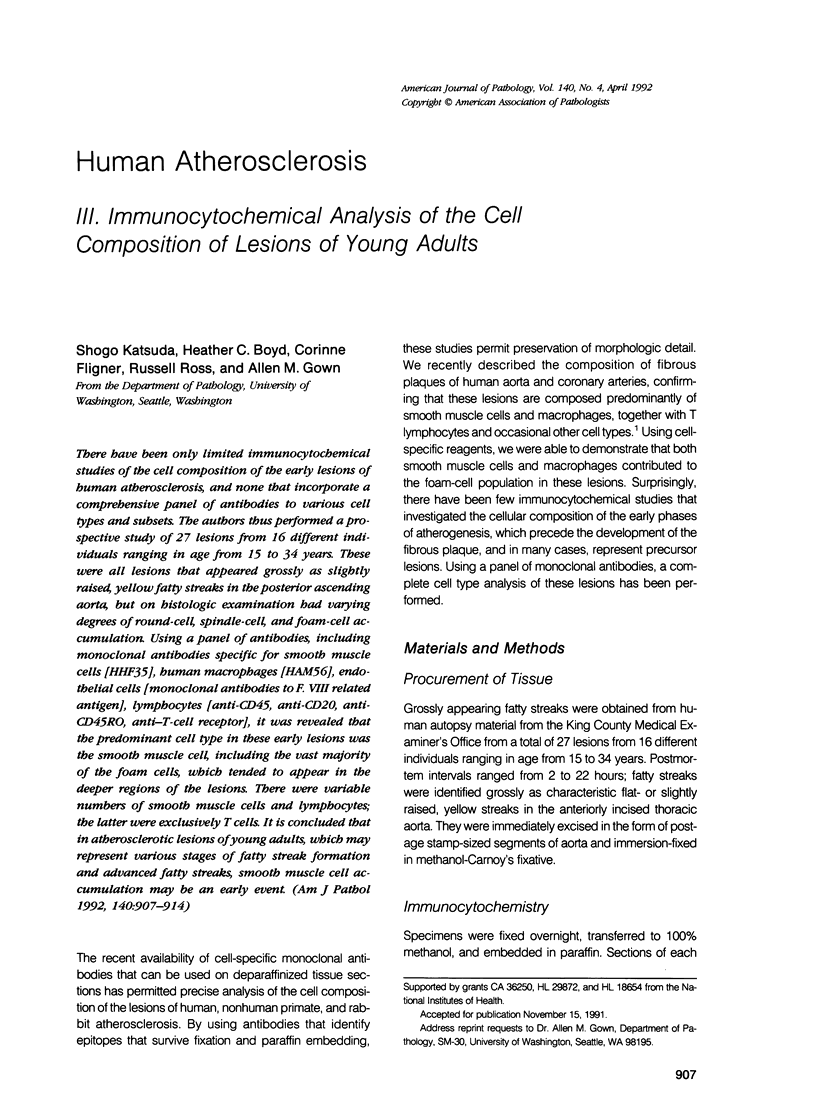
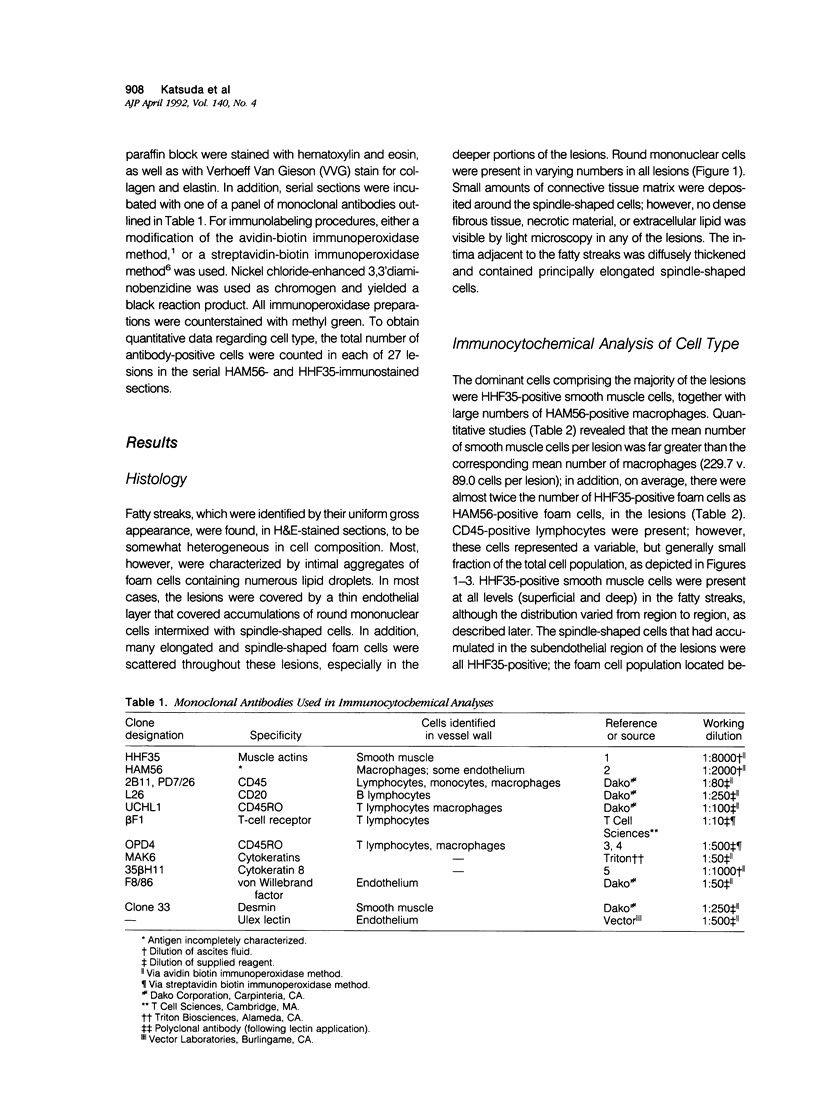
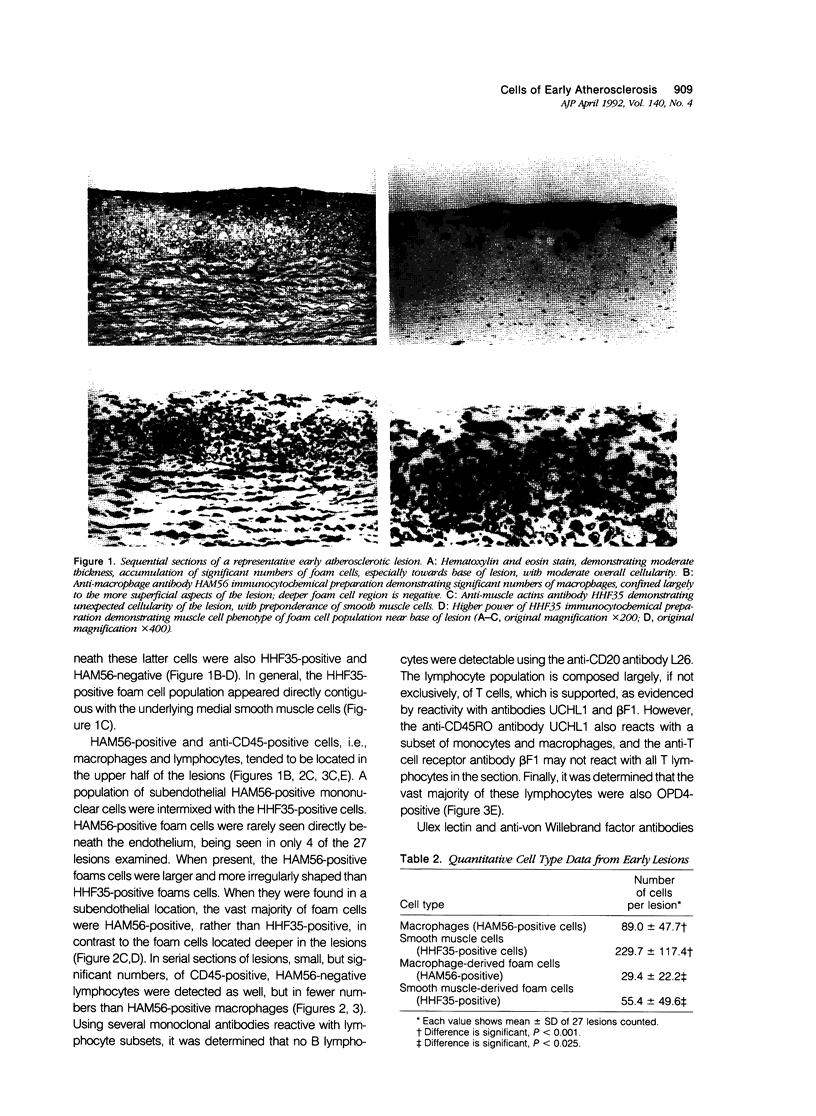
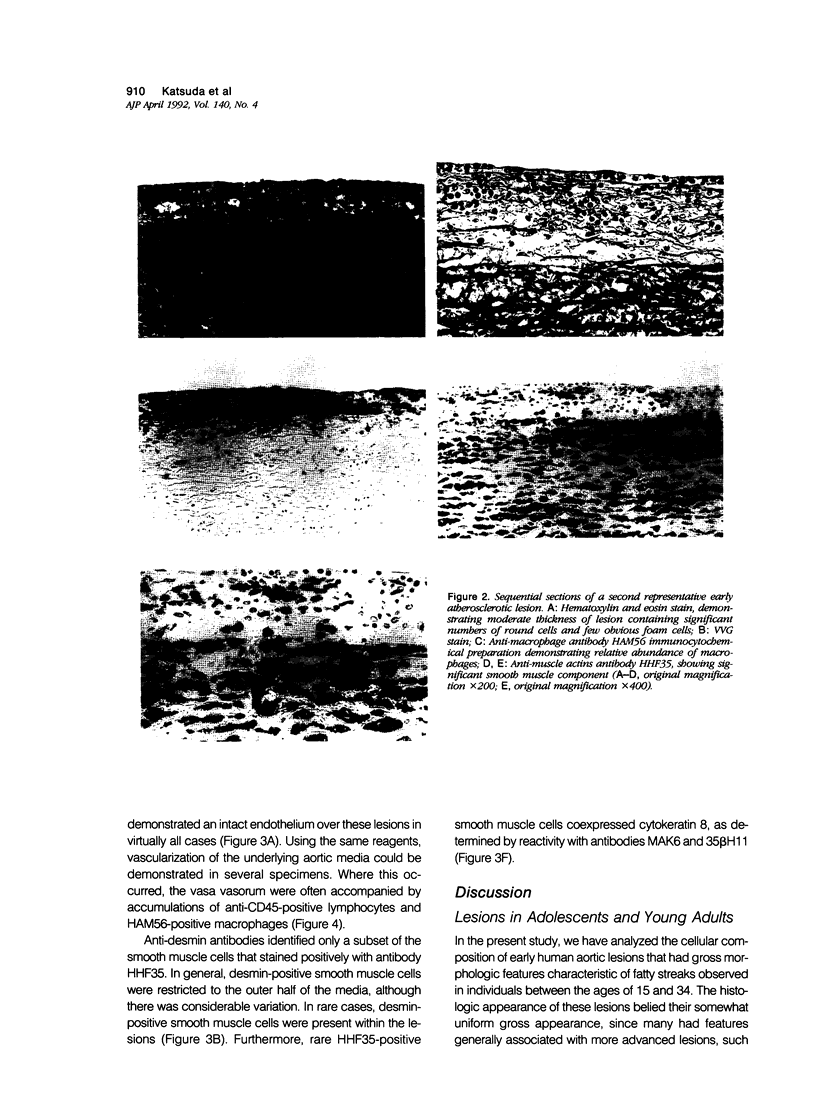
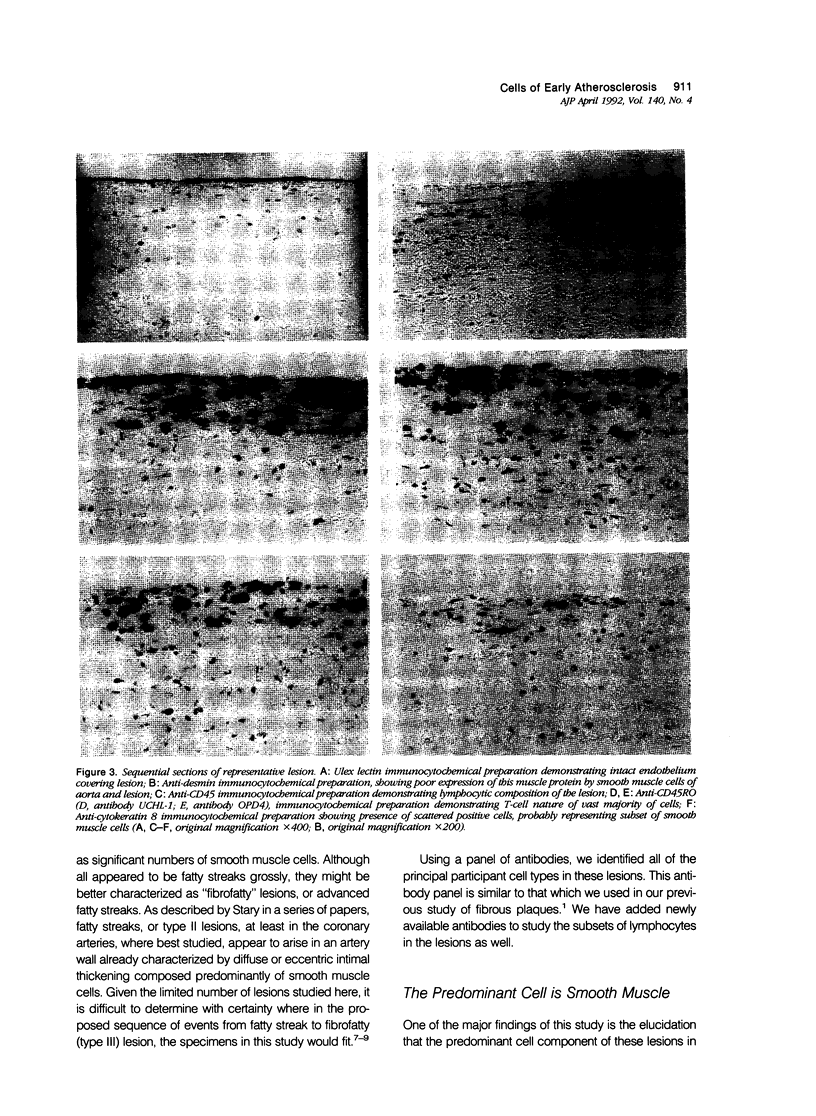
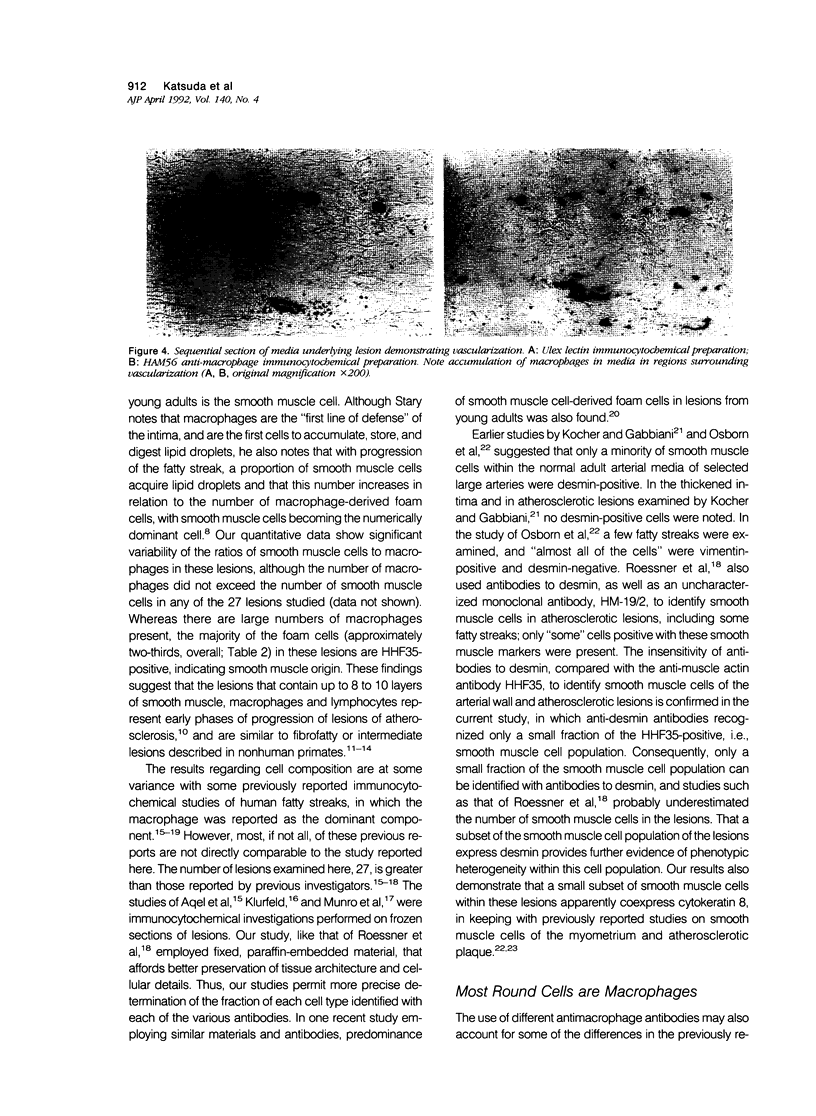
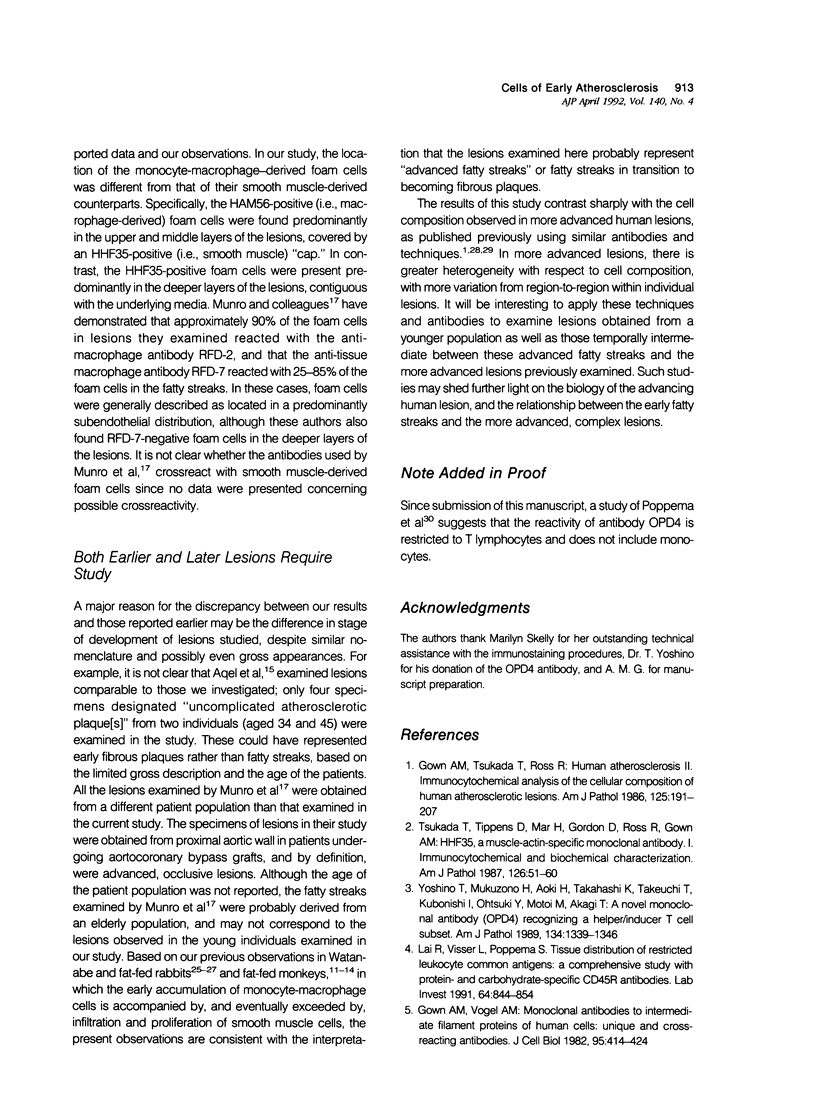
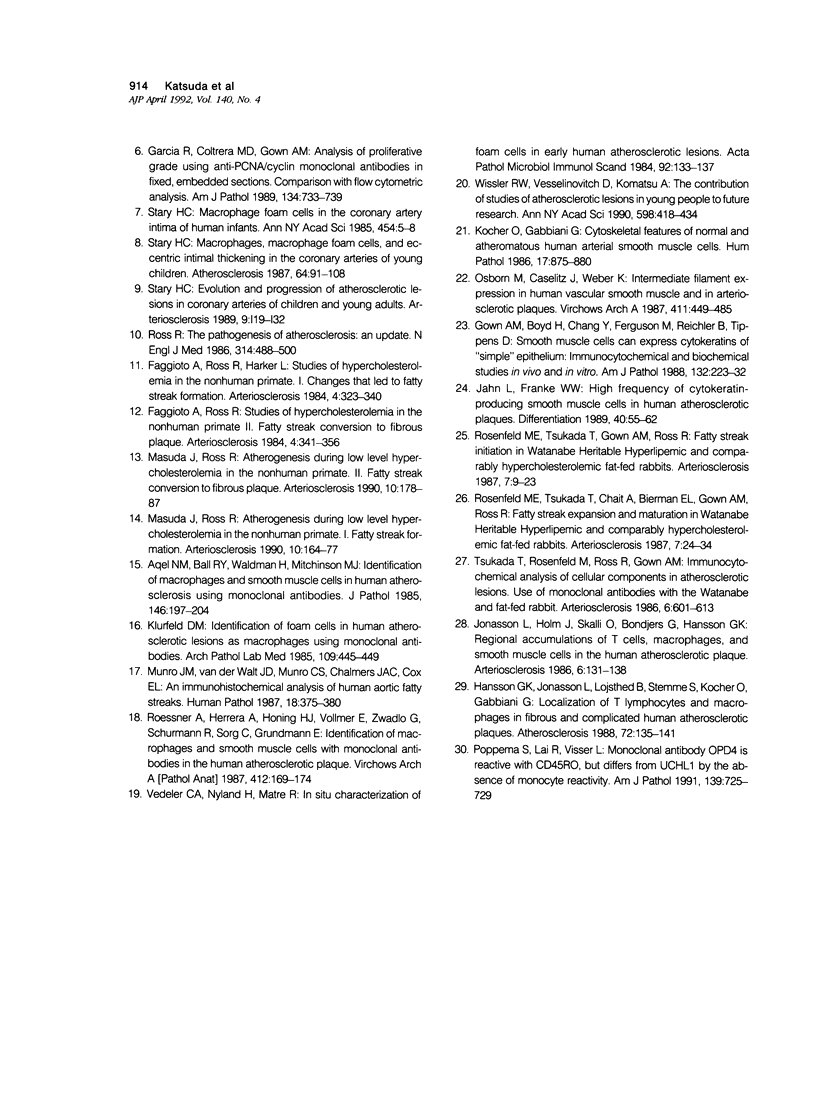
Images in this article
Selected References
These references are in PubMed. This may not be the complete list of references from this article.
- Aqel N. M., Ball R. Y., Waldmann H., Mitchinson M. J. Identification of macrophages and smooth muscle cells in human atherosclerosis using monoclonal antibodies. J Pathol. 1985 Jul;146(3):197–204. doi: 10.1002/path.1711460306. [DOI] [PubMed] [Google Scholar]
- Faggiotto A., Ross R., Harker L. Studies of hypercholesterolemia in the nonhuman primate. I. Changes that lead to fatty streak formation. Arteriosclerosis. 1984 Jul-Aug;4(4):323–340. doi: 10.1161/01.atv.4.4.323. [DOI] [PubMed] [Google Scholar]
- Faggiotto A., Ross R. Studies of hypercholesterolemia in the nonhuman primate. II. Fatty streak conversion to fibrous plaque. Arteriosclerosis. 1984 Jul-Aug;4(4):341–356. doi: 10.1161/01.atv.4.4.341. [DOI] [PubMed] [Google Scholar]
- Garcia R. L., Coltrera M. D., Gown A. M. Analysis of proliferative grade using anti-PCNA/cyclin monoclonal antibodies in fixed, embedded tissues. Comparison with flow cytometric analysis. Am J Pathol. 1989 Apr;134(4):733–739. [PMC free article] [PubMed] [Google Scholar]
- Gown A. M., Boyd H. C., Chang Y., Ferguson M., Reichler B., Tippens D. Smooth muscle cells can express cytokeratins of "simple" epithelium. Immunocytochemical and biochemical studies in vitro and in vivo. Am J Pathol. 1988 Aug;132(2):223–232. [PMC free article] [PubMed] [Google Scholar]
- Gown A. M., Tsukada T., Ross R. Human atherosclerosis. II. Immunocytochemical analysis of the cellular composition of human atherosclerotic lesions. Am J Pathol. 1986 Oct;125(1):191–207. [PMC free article] [PubMed] [Google Scholar]
- Gown A. M., Vogel A. M. Monoclonal antibodies to intermediate filament proteins of human cells: unique and cross-reacting antibodies. J Cell Biol. 1982 Nov;95(2 Pt 1):414–424. doi: 10.1083/jcb.95.2.414. [DOI] [PMC free article] [PubMed] [Google Scholar]
- Hansson G. K., Jonasson L., Lojsthed B., Stemme S., Kocher O., Gabbiani G. Localization of T lymphocytes and macrophages in fibrous and complicated human atherosclerotic plaques. Atherosclerosis. 1988 Aug;72(2-3):135–141. doi: 10.1016/0021-9150(88)90074-3. [DOI] [PubMed] [Google Scholar]
- Jahn L., Franke W. W. High frequency of cytokeratin-producing smooth muscle cells in human atherosclerotic plaques. Differentiation. 1989 Mar;40(1):55–62. doi: 10.1111/j.1432-0436.1989.tb00813.x. [DOI] [PubMed] [Google Scholar]
- Jonasson L., Holm J., Skalli O., Bondjers G., Hansson G. K. Regional accumulations of T cells, macrophages, and smooth muscle cells in the human atherosclerotic plaque. Arteriosclerosis. 1986 Mar-Apr;6(2):131–138. doi: 10.1161/01.atv.6.2.131. [DOI] [PubMed] [Google Scholar]
- Klurfeld D. M. Identification of foam cells in human atherosclerotic lesions as macrophages using monoclonal antibodies. Arch Pathol Lab Med. 1985 May;109(5):445–449. [PubMed] [Google Scholar]
- Kocher O., Gabbiani G. Cytoskeletal features of normal and atheromatous human arterial smooth muscle cells. Hum Pathol. 1986 Sep;17(9):875–880. doi: 10.1016/s0046-8177(86)80637-2. [DOI] [PubMed] [Google Scholar]
- Lai R., Visser L., Poppema S. Tissue distribution of restricted leukocyte common antigens. A comprehensive study with protein- and carbohydrate-specific CD45R antibodies. Lab Invest. 1991 Jun;64(6):844–854. [PubMed] [Google Scholar]
- Masuda J., Ross R. Atherogenesis during low level hypercholesterolemia in the nonhuman primate. I. Fatty streak formation. Arteriosclerosis. 1990 Mar-Apr;10(2):164–177. doi: 10.1161/01.atv.10.2.164. [DOI] [PubMed] [Google Scholar]
- Masuda J., Ross R. Atherogenesis during low level hypercholesterolemia in the nonhuman primate. II. Fatty streak conversion to fibrous plaque. Arteriosclerosis. 1990 Mar-Apr;10(2):178–187. doi: 10.1161/01.atv.10.2.178. [DOI] [PubMed] [Google Scholar]
- Munro J. M., van der Walt J. D., Munro C. S., Chalmers J. A., Cox E. L. An immunohistochemical analysis of human aortic fatty streaks. Hum Pathol. 1987 Apr;18(4):375–380. doi: 10.1016/s0046-8177(87)80168-5. [DOI] [PubMed] [Google Scholar]
- Osborn M., Caselitz J., Püschel K., Weber K. Intermediate filament expression in human vascular smooth muscle and in arteriosclerotic plaques. Virchows Arch A Pathol Anat Histopathol. 1987;411(5):449–458. doi: 10.1007/BF00735226. [DOI] [PubMed] [Google Scholar]
- Poppema S., Lai R., Visser L. Monoclonal antibody OPD4 is reactive with CD45RO, but differs from UCHL1 by the absence of monocyte reactivity. Am J Pathol. 1991 Oct;139(4):725–729. [PMC free article] [PubMed] [Google Scholar]
- Roessner A., Herrera A., Höning H. J., Vollmer E., Zwadlo G., Schürmann R., Sorg C., Grundmann E. Identification of macrophages and smooth muscle cells with monoclonal antibodies in the human atherosclerotic plaque. Virchows Arch A Pathol Anat Histopathol. 1987;412(2):169–174. doi: 10.1007/BF00716190. [DOI] [PubMed] [Google Scholar]
- Rosenfeld M. E., Tsukada T., Chait A., Bierman E. L., Gown A. M., Ross R. Fatty streak expansion and maturation in Watanabe Heritable Hyperlipemic and comparably hypercholesterolemic fat-fed rabbits. Arteriosclerosis. 1987 Jan-Feb;7(1):24–34. doi: 10.1161/01.atv.7.1.24. [DOI] [PubMed] [Google Scholar]
- Rosenfeld M. E., Tsukada T., Gown A. M., Ross R. Fatty streak initiation in Watanabe Heritable Hyperlipemic and comparably hypercholesterolemic fat-fed rabbits. Arteriosclerosis. 1987 Jan-Feb;7(1):9–23. doi: 10.1161/01.atv.7.1.9. [DOI] [PubMed] [Google Scholar]
- Ross R. The pathogenesis of atherosclerosis--an update. N Engl J Med. 1986 Feb 20;314(8):488–500. doi: 10.1056/NEJM198602203140806. [DOI] [PubMed] [Google Scholar]
- Stary H. C. Macrophage foam cells in the coronary artery intima of human infants. Ann N Y Acad Sci. 1985;454:5–8. doi: 10.1111/j.1749-6632.1985.tb11839.x. [DOI] [PubMed] [Google Scholar]
- Stary H. C. Macrophages, macrophage foam cells, and eccentric intimal thickening in the coronary arteries of young children. Atherosclerosis. 1987 Apr;64(2-3):91–108. doi: 10.1016/0021-9150(87)90234-6. [DOI] [PubMed] [Google Scholar]
- Tsukada T., Rosenfeld M., Ross R., Gown A. M. Immunocytochemical analysis of cellular components in atherosclerotic lesions. Use of monoclonal antibodies with the Watanabe and fat-fed rabbit. Arteriosclerosis. 1986 Nov-Dec;6(6):601–613. doi: 10.1161/01.atv.6.6.601. [DOI] [PubMed] [Google Scholar]
- Tsukada T., Tippens D., Gordon D., Ross R., Gown A. M. HHF35, a muscle-actin-specific monoclonal antibody. I. Immunocytochemical and biochemical characterization. Am J Pathol. 1987 Jan;126(1):51–60. [PMC free article] [PubMed] [Google Scholar]
- Vedeler C. A., Nyland H., Matre R. In situ characterization of the foam cells in early human atherosclerotic lesions. Acta Pathol Microbiol Immunol Scand C. 1984 Apr;92(2):133–137. doi: 10.1111/j.1699-0463.1984.tb00064.x. [DOI] [PubMed] [Google Scholar]
- Wissler R. W., Vesselinovitch D., Komatsu A. The contribution of studies of atherosclerotic lesions in young people to future research. Ann N Y Acad Sci. 1990;598:418–434. doi: 10.1111/j.1749-6632.1990.tb42313.x. [DOI] [PubMed] [Google Scholar]
- Yoshino T., Mukuzono H., Aoki H., Takahashi K., Takeuchi T., Kubonishi I., Ohtsuki Y., Motoi M., Akagi T. A novel monoclonal antibody (OPD4) recognizing a helper/inducer T cell subset. Its application to paraffin-embedded tissues. Am J Pathol. 1989 Jun;134(6):1339–1346. [PMC free article] [PubMed] [Google Scholar]






